Semitransparent Perovskite Based Solar Cells
VerifiedAdded on 2023/06/15
|12
|2468
|430
AI Summary
This article discusses the working of semitransparent perovskite based solar cells, recent and future trends, and important research. It also highlights the importance of perovskite solar cells in the world of photovoltaics. The article is relevant for students studying chemistry, physics, and engineering.
Contribute Materials
Your contribution can guide someone’s learning journey. Share your
documents today.
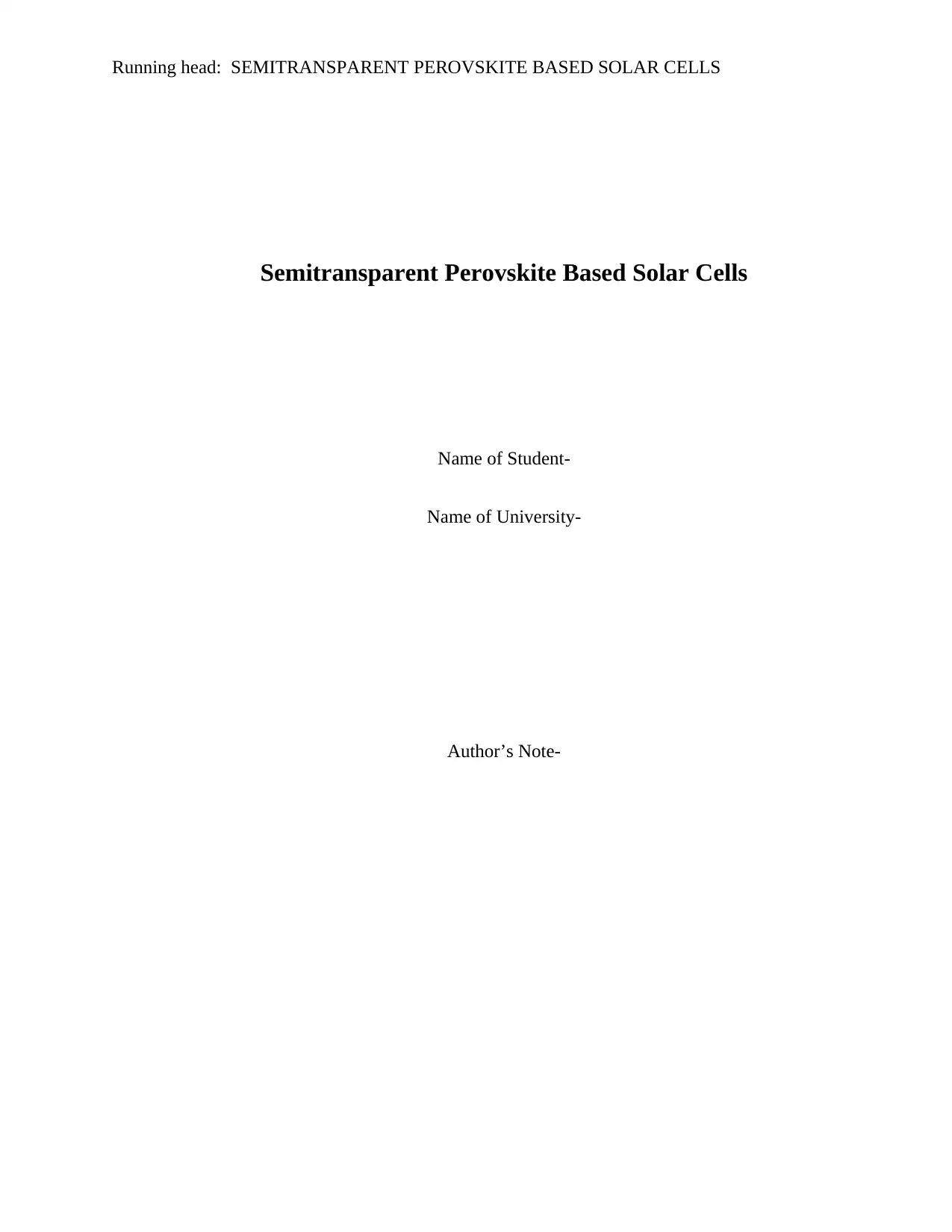
Running head: SEMITRANSPARENT PEROVSKITE BASED SOLAR CELLS
Semitransparent Perovskite Based Solar Cells
Name of Student-
Name of University-
Author’s Note-
Semitransparent Perovskite Based Solar Cells
Name of Student-
Name of University-
Author’s Note-
Secure Best Marks with AI Grader
Need help grading? Try our AI Grader for instant feedback on your assignments.
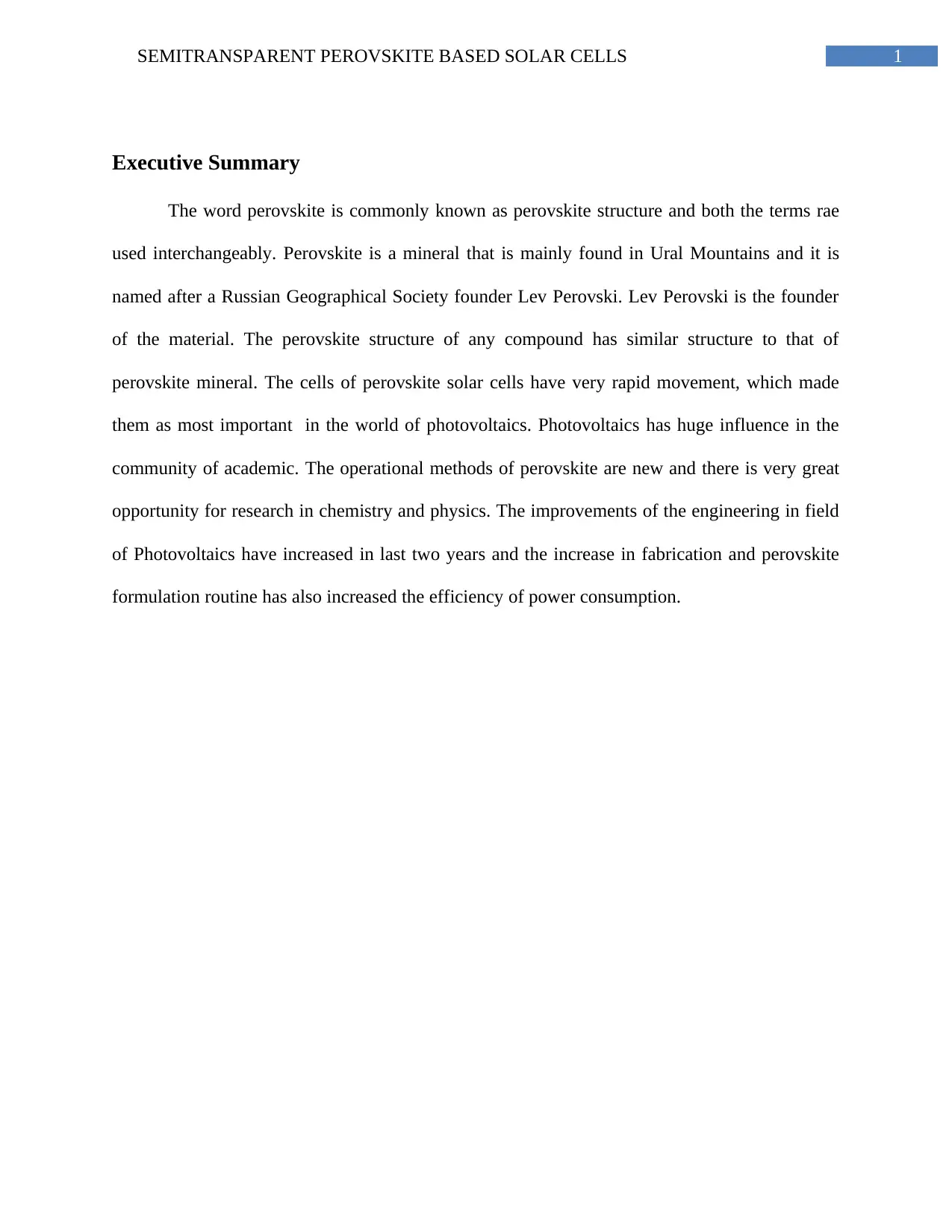
1SEMITRANSPARENT PEROVSKITE BASED SOLAR CELLS
Executive Summary
The word perovskite is commonly known as perovskite structure and both the terms rae
used interchangeably. Perovskite is a mineral that is mainly found in Ural Mountains and it is
named after a Russian Geographical Society founder Lev Perovski. Lev Perovski is the founder
of the material. The perovskite structure of any compound has similar structure to that of
perovskite mineral. The cells of perovskite solar cells have very rapid movement, which made
them as most important in the world of photovoltaics. Photovoltaics has huge influence in the
community of academic. The operational methods of perovskite are new and there is very great
opportunity for research in chemistry and physics. The improvements of the engineering in field
of Photovoltaics have increased in last two years and the increase in fabrication and perovskite
formulation routine has also increased the efficiency of power consumption.
Executive Summary
The word perovskite is commonly known as perovskite structure and both the terms rae
used interchangeably. Perovskite is a mineral that is mainly found in Ural Mountains and it is
named after a Russian Geographical Society founder Lev Perovski. Lev Perovski is the founder
of the material. The perovskite structure of any compound has similar structure to that of
perovskite mineral. The cells of perovskite solar cells have very rapid movement, which made
them as most important in the world of photovoltaics. Photovoltaics has huge influence in the
community of academic. The operational methods of perovskite are new and there is very great
opportunity for research in chemistry and physics. The improvements of the engineering in field
of Photovoltaics have increased in last two years and the increase in fabrication and perovskite
formulation routine has also increased the efficiency of power consumption.
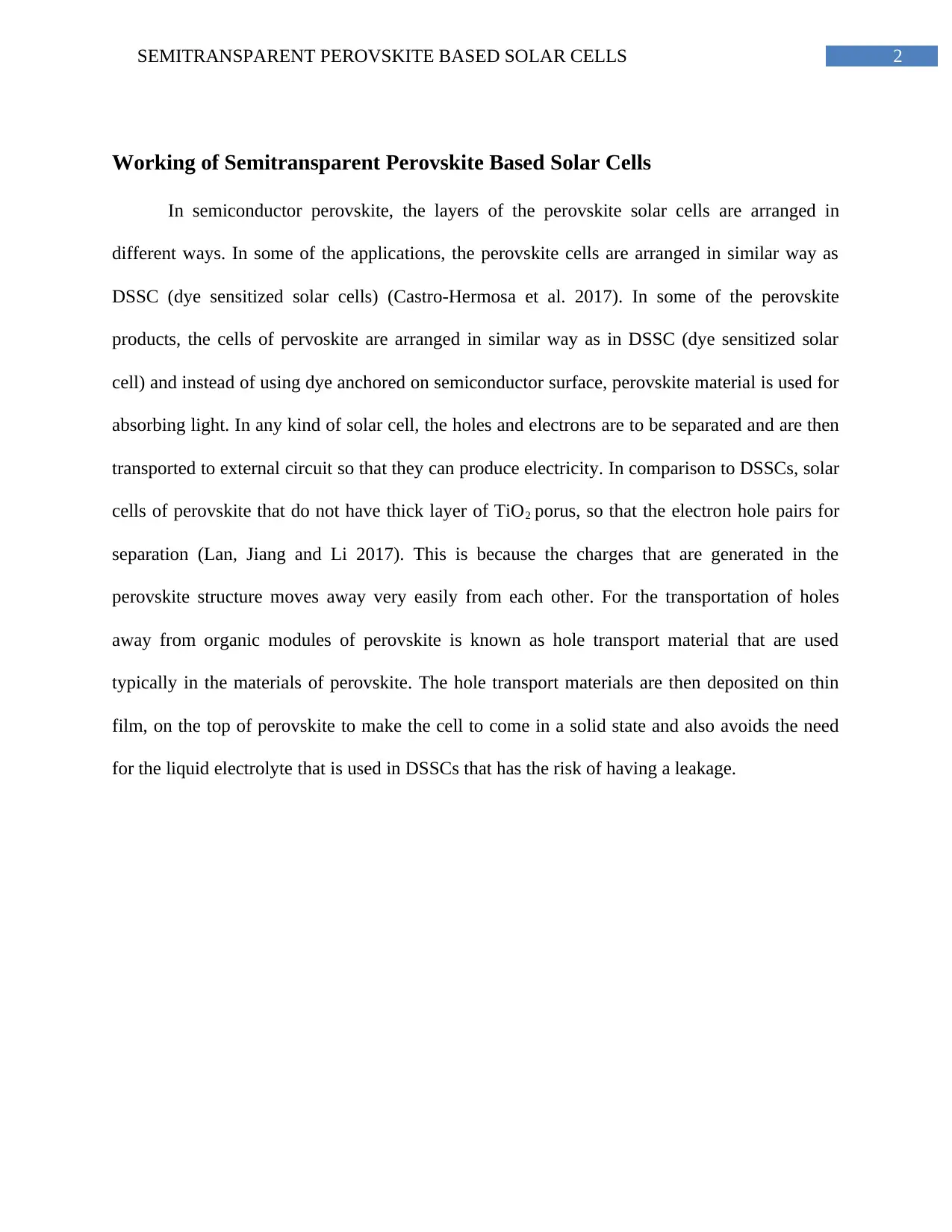
2SEMITRANSPARENT PEROVSKITE BASED SOLAR CELLS
Working of Semitransparent Perovskite Based Solar Cells
In semiconductor perovskite, the layers of the perovskite solar cells are arranged in
different ways. In some of the applications, the perovskite cells are arranged in similar way as
DSSC (dye sensitized solar cells) (Castro-Hermosa et al. 2017). In some of the perovskite
products, the cells of pervoskite are arranged in similar way as in DSSC (dye sensitized solar
cell) and instead of using dye anchored on semiconductor surface, perovskite material is used for
absorbing light. In any kind of solar cell, the holes and electrons are to be separated and are then
transported to external circuit so that they can produce electricity. In comparison to DSSCs, solar
cells of perovskite that do not have thick layer of TiO2 porus, so that the electron hole pairs for
separation (Lan, Jiang and Li 2017). This is because the charges that are generated in the
perovskite structure moves away very easily from each other. For the transportation of holes
away from organic modules of perovskite is known as hole transport material that are used
typically in the materials of perovskite. The hole transport materials are then deposited on thin
film, on the top of perovskite to make the cell to come in a solid state and also avoids the need
for the liquid electrolyte that is used in DSSCs that has the risk of having a leakage.
Working of Semitransparent Perovskite Based Solar Cells
In semiconductor perovskite, the layers of the perovskite solar cells are arranged in
different ways. In some of the applications, the perovskite cells are arranged in similar way as
DSSC (dye sensitized solar cells) (Castro-Hermosa et al. 2017). In some of the perovskite
products, the cells of pervoskite are arranged in similar way as in DSSC (dye sensitized solar
cell) and instead of using dye anchored on semiconductor surface, perovskite material is used for
absorbing light. In any kind of solar cell, the holes and electrons are to be separated and are then
transported to external circuit so that they can produce electricity. In comparison to DSSCs, solar
cells of perovskite that do not have thick layer of TiO2 porus, so that the electron hole pairs for
separation (Lan, Jiang and Li 2017). This is because the charges that are generated in the
perovskite structure moves away very easily from each other. For the transportation of holes
away from organic modules of perovskite is known as hole transport material that are used
typically in the materials of perovskite. The hole transport materials are then deposited on thin
film, on the top of perovskite to make the cell to come in a solid state and also avoids the need
for the liquid electrolyte that is used in DSSCs that has the risk of having a leakage.

3SEMITRANSPARENT PEROVSKITE BASED SOLAR CELLS
Figure 1: The perovskite solar cell
(Source: Lan, Jiang and Li 2017)
The solar cells that are mainly based on organometal trihalide perovskite are very light
absorber which recently have emerged as most promising class of photovoltaic device (Zhou et
al. 2016). The devices that are based on perovskite solar cells have low fabrication cost and have
high performances if the solar cells are semitransparent and also is used as a solar window. The
perovskite solar cells are highly efficient with very high transparency in visible spectrum that has
been developed (Duong et al. 2016). There are dielectric-metal-dielectric with multilayered top
Figure 1: The perovskite solar cell
(Source: Lan, Jiang and Li 2017)
The solar cells that are mainly based on organometal trihalide perovskite are very light
absorber which recently have emerged as most promising class of photovoltaic device (Zhou et
al. 2016). The devices that are based on perovskite solar cells have low fabrication cost and have
high performances if the solar cells are semitransparent and also is used as a solar window. The
perovskite solar cells are highly efficient with very high transparency in visible spectrum that has
been developed (Duong et al. 2016). There are dielectric-metal-dielectric with multilayered top
Secure Best Marks with AI Grader
Need help grading? Try our AI Grader for instant feedback on your assignments.
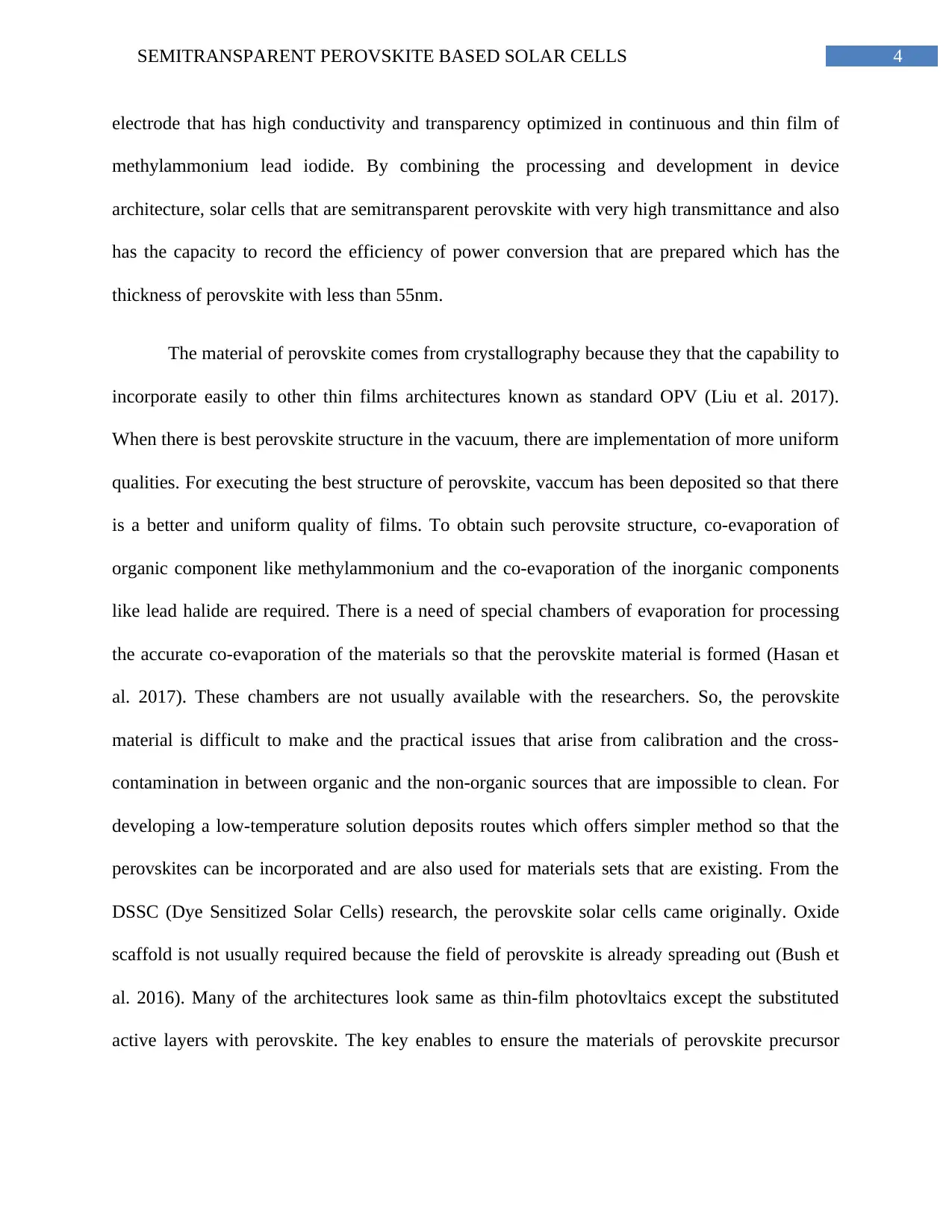
4SEMITRANSPARENT PEROVSKITE BASED SOLAR CELLS
electrode that has high conductivity and transparency optimized in continuous and thin film of
methylammonium lead iodide. By combining the processing and development in device
architecture, solar cells that are semitransparent perovskite with very high transmittance and also
has the capacity to record the efficiency of power conversion that are prepared which has the
thickness of perovskite with less than 55nm.
The material of perovskite comes from crystallography because they that the capability to
incorporate easily to other thin films architectures known as standard OPV (Liu et al. 2017).
When there is best perovskite structure in the vacuum, there are implementation of more uniform
qualities. For executing the best structure of perovskite, vaccum has been deposited so that there
is a better and uniform quality of films. To obtain such perovsite structure, co-evaporation of
organic component like methylammonium and the co-evaporation of the inorganic components
like lead halide are required. There is a need of special chambers of evaporation for processing
the accurate co-evaporation of the materials so that the perovskite material is formed (Hasan et
al. 2017). These chambers are not usually available with the researchers. So, the perovskite
material is difficult to make and the practical issues that arise from calibration and the cross-
contamination in between organic and the non-organic sources that are impossible to clean. For
developing a low-temperature solution deposits routes which offers simpler method so that the
perovskites can be incorporated and are also used for materials sets that are existing. From the
DSSC (Dye Sensitized Solar Cells) research, the perovskite solar cells came originally. Oxide
scaffold is not usually required because the field of perovskite is already spreading out (Bush et
al. 2016). Many of the architectures look same as thin-film photovltaics except the substituted
active layers with perovskite. The key enables to ensure the materials of perovskite precursor
electrode that has high conductivity and transparency optimized in continuous and thin film of
methylammonium lead iodide. By combining the processing and development in device
architecture, solar cells that are semitransparent perovskite with very high transmittance and also
has the capacity to record the efficiency of power conversion that are prepared which has the
thickness of perovskite with less than 55nm.
The material of perovskite comes from crystallography because they that the capability to
incorporate easily to other thin films architectures known as standard OPV (Liu et al. 2017).
When there is best perovskite structure in the vacuum, there are implementation of more uniform
qualities. For executing the best structure of perovskite, vaccum has been deposited so that there
is a better and uniform quality of films. To obtain such perovsite structure, co-evaporation of
organic component like methylammonium and the co-evaporation of the inorganic components
like lead halide are required. There is a need of special chambers of evaporation for processing
the accurate co-evaporation of the materials so that the perovskite material is formed (Hasan et
al. 2017). These chambers are not usually available with the researchers. So, the perovskite
material is difficult to make and the practical issues that arise from calibration and the cross-
contamination in between organic and the non-organic sources that are impossible to clean. For
developing a low-temperature solution deposits routes which offers simpler method so that the
perovskites can be incorporated and are also used for materials sets that are existing. From the
DSSC (Dye Sensitized Solar Cells) research, the perovskite solar cells came originally. Oxide
scaffold is not usually required because the field of perovskite is already spreading out (Bush et
al. 2016). Many of the architectures look same as thin-film photovltaics except the substituted
active layers with perovskite. The key enables to ensure the materials of perovskite precursor
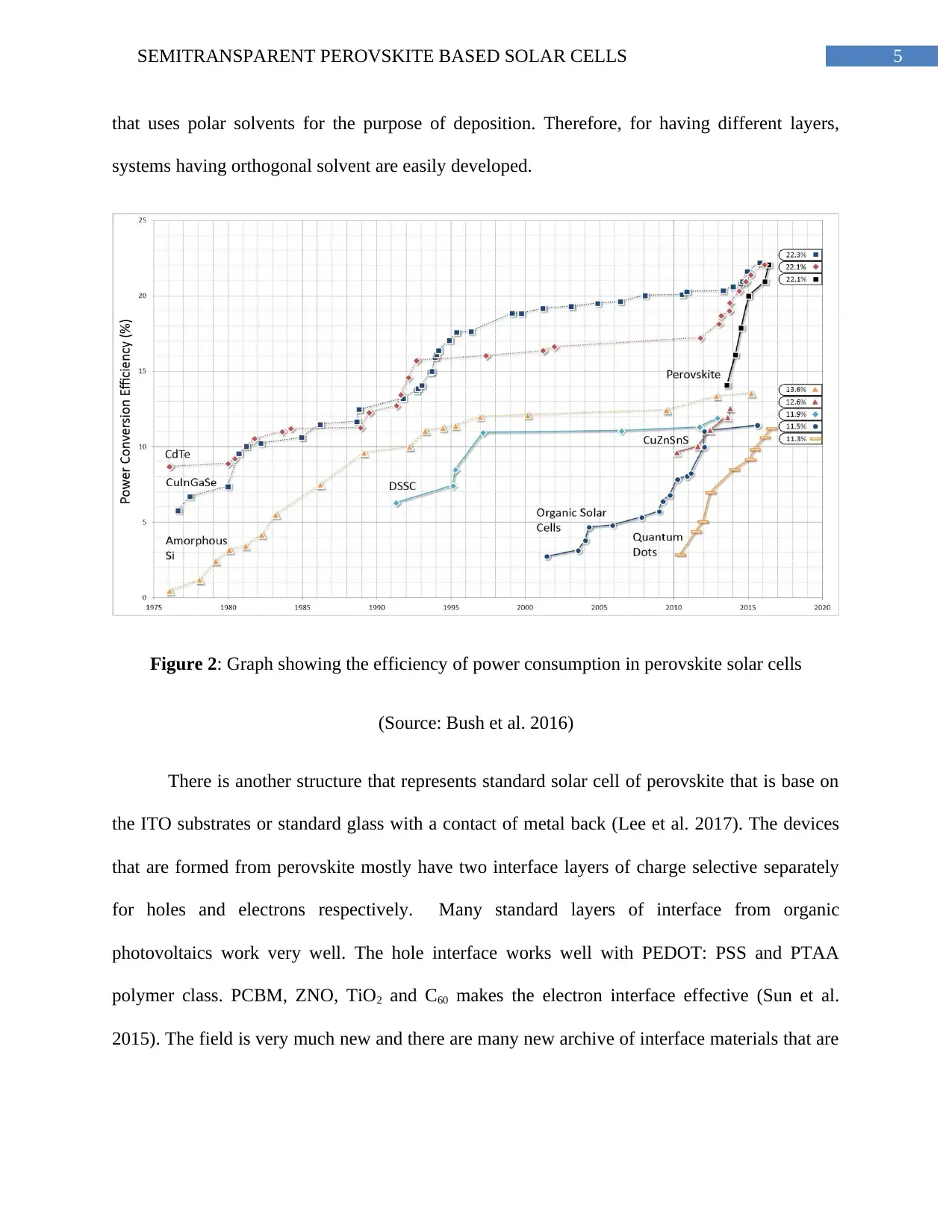
5SEMITRANSPARENT PEROVSKITE BASED SOLAR CELLS
that uses polar solvents for the purpose of deposition. Therefore, for having different layers,
systems having orthogonal solvent are easily developed.
Figure 2: Graph showing the efficiency of power consumption in perovskite solar cells
(Source: Bush et al. 2016)
There is another structure that represents standard solar cell of perovskite that is base on
the ITO substrates or standard glass with a contact of metal back (Lee et al. 2017). The devices
that are formed from perovskite mostly have two interface layers of charge selective separately
for holes and electrons respectively. Many standard layers of interface from organic
photovoltaics work very well. The hole interface works well with PEDOT: PSS and PTAA
polymer class. PCBM, ZNO, TiO2 and C60 makes the electron interface effective (Sun et al.
2015). The field is very much new and there are many new archive of interface materials that are
that uses polar solvents for the purpose of deposition. Therefore, for having different layers,
systems having orthogonal solvent are easily developed.
Figure 2: Graph showing the efficiency of power consumption in perovskite solar cells
(Source: Bush et al. 2016)
There is another structure that represents standard solar cell of perovskite that is base on
the ITO substrates or standard glass with a contact of metal back (Lee et al. 2017). The devices
that are formed from perovskite mostly have two interface layers of charge selective separately
for holes and electrons respectively. Many standard layers of interface from organic
photovoltaics work very well. The hole interface works well with PEDOT: PSS and PTAA
polymer class. PCBM, ZNO, TiO2 and C60 makes the electron interface effective (Sun et al.
2015). The field is very much new and there are many new archive of interface materials that are
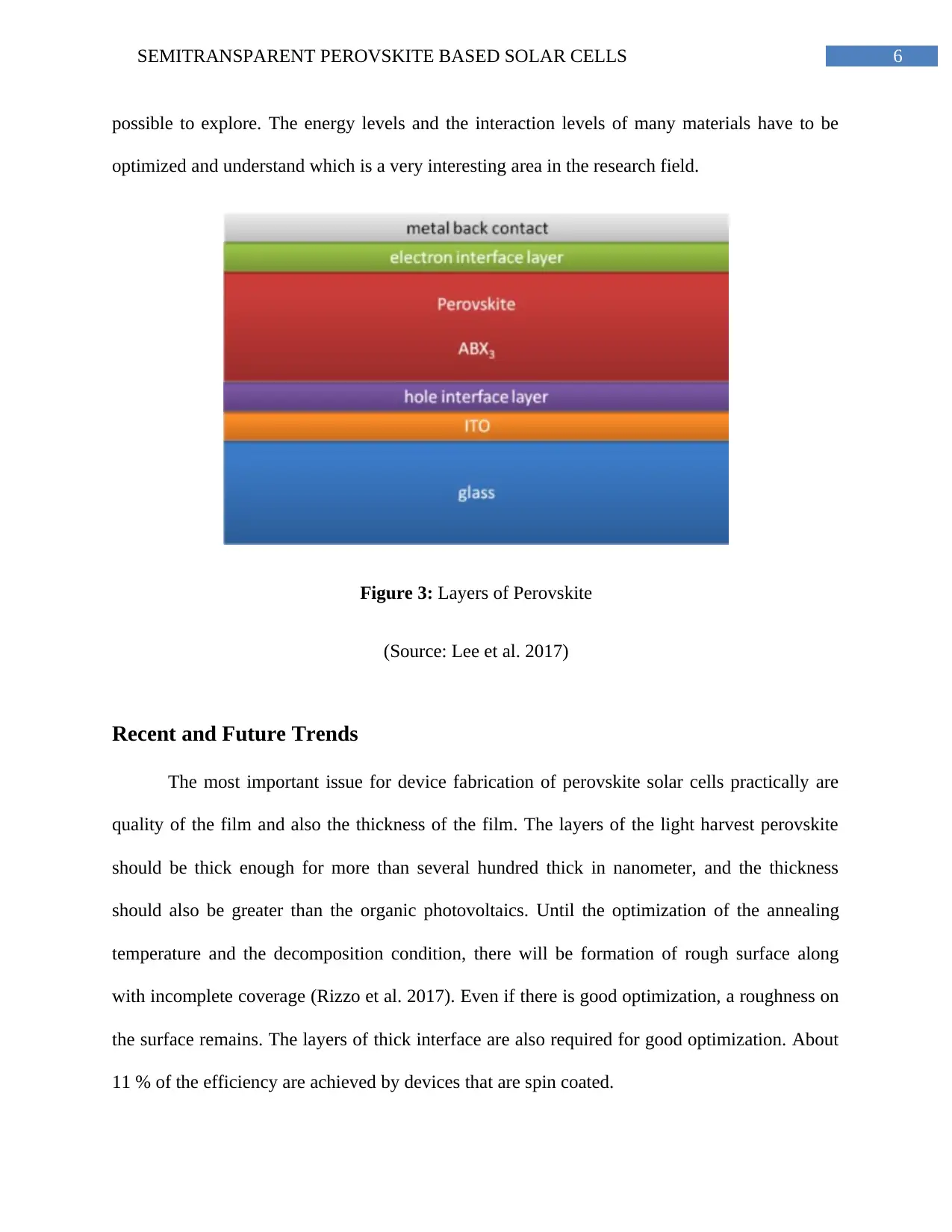
6SEMITRANSPARENT PEROVSKITE BASED SOLAR CELLS
possible to explore. The energy levels and the interaction levels of many materials have to be
optimized and understand which is a very interesting area in the research field.
Figure 3: Layers of Perovskite
(Source: Lee et al. 2017)
Recent and Future Trends
The most important issue for device fabrication of perovskite solar cells practically are
quality of the film and also the thickness of the film. The layers of the light harvest perovskite
should be thick enough for more than several hundred thick in nanometer, and the thickness
should also be greater than the organic photovoltaics. Until the optimization of the annealing
temperature and the decomposition condition, there will be formation of rough surface along
with incomplete coverage (Rizzo et al. 2017). Even if there is good optimization, a roughness on
the surface remains. The layers of thick interface are also required for good optimization. About
11 % of the efficiency are achieved by devices that are spin coated.
possible to explore. The energy levels and the interaction levels of many materials have to be
optimized and understand which is a very interesting area in the research field.
Figure 3: Layers of Perovskite
(Source: Lee et al. 2017)
Recent and Future Trends
The most important issue for device fabrication of perovskite solar cells practically are
quality of the film and also the thickness of the film. The layers of the light harvest perovskite
should be thick enough for more than several hundred thick in nanometer, and the thickness
should also be greater than the organic photovoltaics. Until the optimization of the annealing
temperature and the decomposition condition, there will be formation of rough surface along
with incomplete coverage (Rizzo et al. 2017). Even if there is good optimization, a roughness on
the surface remains. The layers of thick interface are also required for good optimization. About
11 % of the efficiency are achieved by devices that are spin coated.
Paraphrase This Document
Need a fresh take? Get an instant paraphrase of this document with our AI Paraphraser
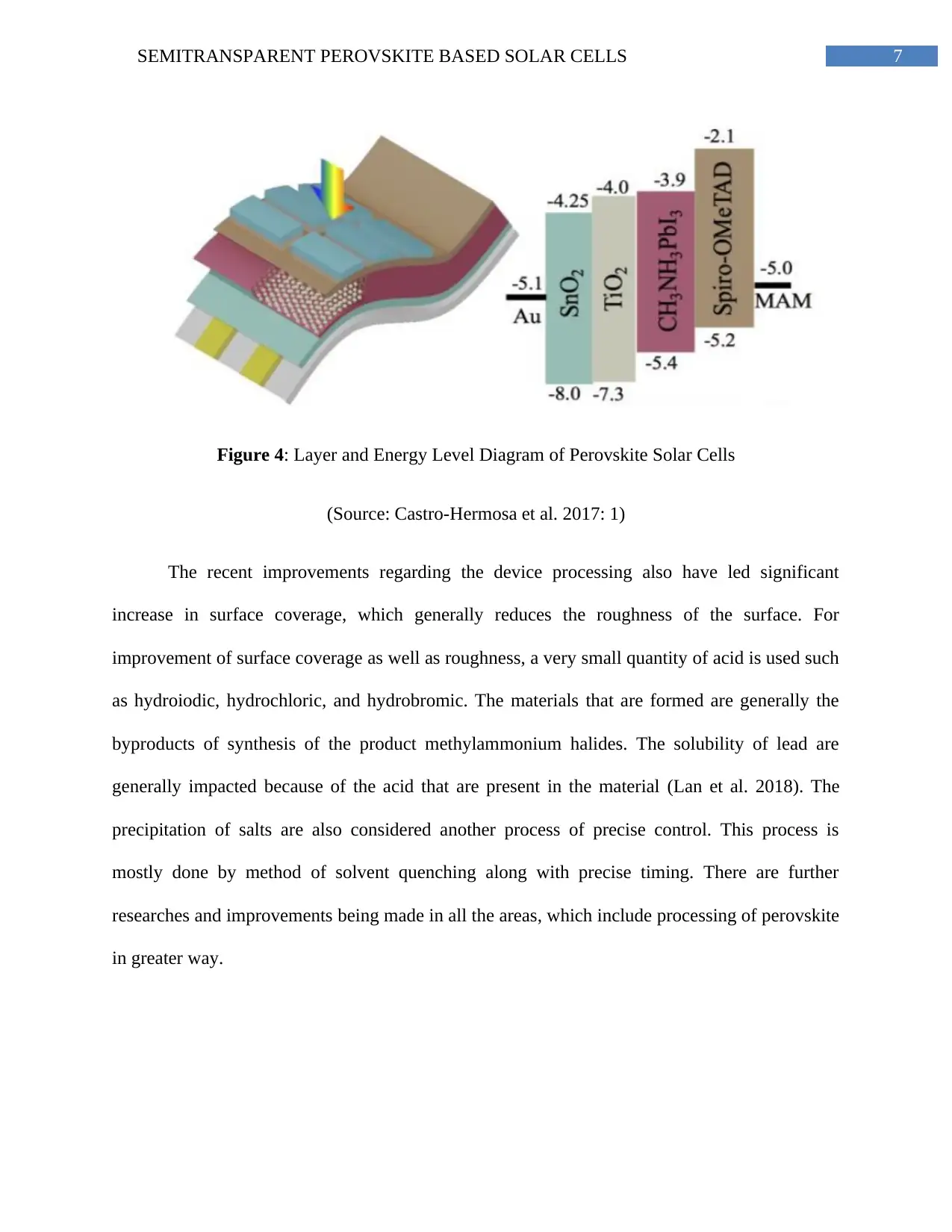
7SEMITRANSPARENT PEROVSKITE BASED SOLAR CELLS
Figure 4: Layer and Energy Level Diagram of Perovskite Solar Cells
(Source: Castro-Hermosa et al. 2017: 1)
The recent improvements regarding the device processing also have led significant
increase in surface coverage, which generally reduces the roughness of the surface. For
improvement of surface coverage as well as roughness, a very small quantity of acid is used such
as hydroiodic, hydrochloric, and hydrobromic. The materials that are formed are generally the
byproducts of synthesis of the product methylammonium halides. The solubility of lead are
generally impacted because of the acid that are present in the material (Lan et al. 2018). The
precipitation of salts are also considered another process of precise control. This process is
mostly done by method of solvent quenching along with precise timing. There are further
researches and improvements being made in all the areas, which include processing of perovskite
in greater way.
Figure 4: Layer and Energy Level Diagram of Perovskite Solar Cells
(Source: Castro-Hermosa et al. 2017: 1)
The recent improvements regarding the device processing also have led significant
increase in surface coverage, which generally reduces the roughness of the surface. For
improvement of surface coverage as well as roughness, a very small quantity of acid is used such
as hydroiodic, hydrochloric, and hydrobromic. The materials that are formed are generally the
byproducts of synthesis of the product methylammonium halides. The solubility of lead are
generally impacted because of the acid that are present in the material (Lan et al. 2018). The
precipitation of salts are also considered another process of precise control. This process is
mostly done by method of solvent quenching along with precise timing. There are further
researches and improvements being made in all the areas, which include processing of perovskite
in greater way.
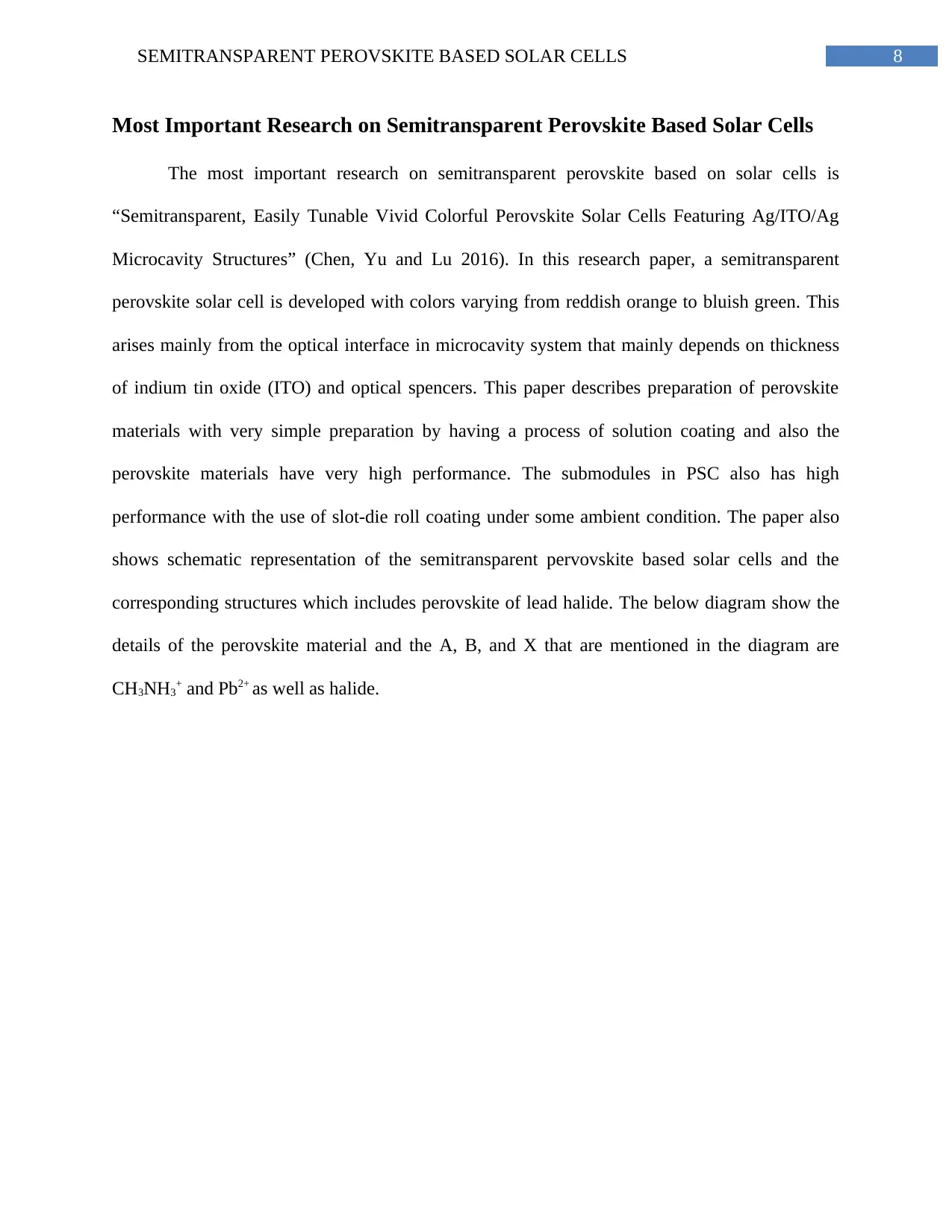
8SEMITRANSPARENT PEROVSKITE BASED SOLAR CELLS
Most Important Research on Semitransparent Perovskite Based Solar Cells
The most important research on semitransparent perovskite based on solar cells is
“Semitransparent, Easily Tunable Vivid Colorful Perovskite Solar Cells Featuring Ag/ITO/Ag
Microcavity Structures” (Chen, Yu and Lu 2016). In this research paper, a semitransparent
perovskite solar cell is developed with colors varying from reddish orange to bluish green. This
arises mainly from the optical interface in microcavity system that mainly depends on thickness
of indium tin oxide (ITO) and optical spencers. This paper describes preparation of perovskite
materials with very simple preparation by having a process of solution coating and also the
perovskite materials have very high performance. The submodules in PSC also has high
performance with the use of slot-die roll coating under some ambient condition. The paper also
shows schematic representation of the semitransparent pervovskite based solar cells and the
corresponding structures which includes perovskite of lead halide. The below diagram show the
details of the perovskite material and the A, B, and X that are mentioned in the diagram are
CH3NH3+ and Pb2+ as well as halide.
Most Important Research on Semitransparent Perovskite Based Solar Cells
The most important research on semitransparent perovskite based on solar cells is
“Semitransparent, Easily Tunable Vivid Colorful Perovskite Solar Cells Featuring Ag/ITO/Ag
Microcavity Structures” (Chen, Yu and Lu 2016). In this research paper, a semitransparent
perovskite solar cell is developed with colors varying from reddish orange to bluish green. This
arises mainly from the optical interface in microcavity system that mainly depends on thickness
of indium tin oxide (ITO) and optical spencers. This paper describes preparation of perovskite
materials with very simple preparation by having a process of solution coating and also the
perovskite materials have very high performance. The submodules in PSC also has high
performance with the use of slot-die roll coating under some ambient condition. The paper also
shows schematic representation of the semitransparent pervovskite based solar cells and the
corresponding structures which includes perovskite of lead halide. The below diagram show the
details of the perovskite material and the A, B, and X that are mentioned in the diagram are
CH3NH3+ and Pb2+ as well as halide.
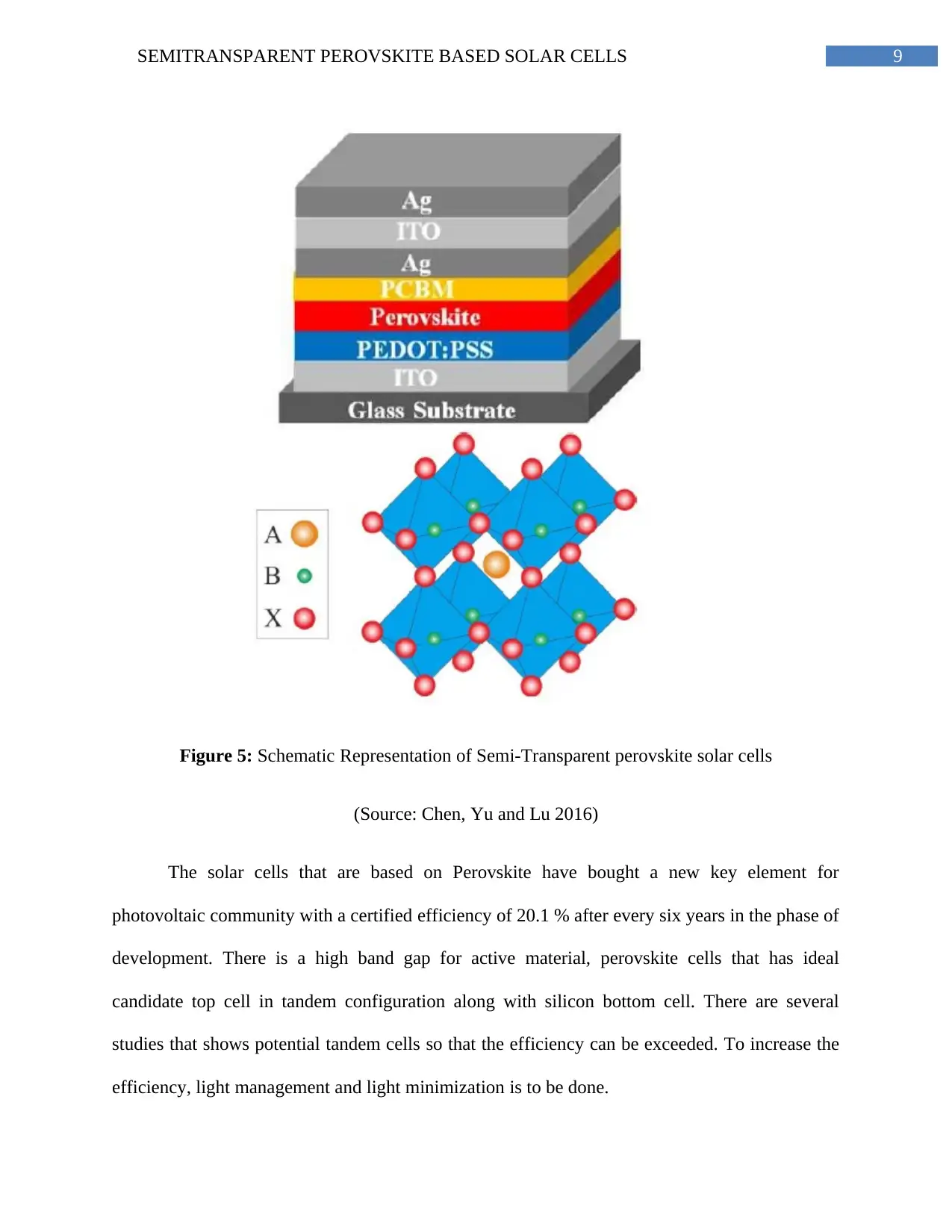
9SEMITRANSPARENT PEROVSKITE BASED SOLAR CELLS
Figure 5: Schematic Representation of Semi-Transparent perovskite solar cells
(Source: Chen, Yu and Lu 2016)
The solar cells that are based on Perovskite have bought a new key element for
photovoltaic community with a certified efficiency of 20.1 % after every six years in the phase of
development. There is a high band gap for active material, perovskite cells that has ideal
candidate top cell in tandem configuration along with silicon bottom cell. There are several
studies that shows potential tandem cells so that the efficiency can be exceeded. To increase the
efficiency, light management and light minimization is to be done.
Figure 5: Schematic Representation of Semi-Transparent perovskite solar cells
(Source: Chen, Yu and Lu 2016)
The solar cells that are based on Perovskite have bought a new key element for
photovoltaic community with a certified efficiency of 20.1 % after every six years in the phase of
development. There is a high band gap for active material, perovskite cells that has ideal
candidate top cell in tandem configuration along with silicon bottom cell. There are several
studies that shows potential tandem cells so that the efficiency can be exceeded. To increase the
efficiency, light management and light minimization is to be done.
Secure Best Marks with AI Grader
Need help grading? Try our AI Grader for instant feedback on your assignments.
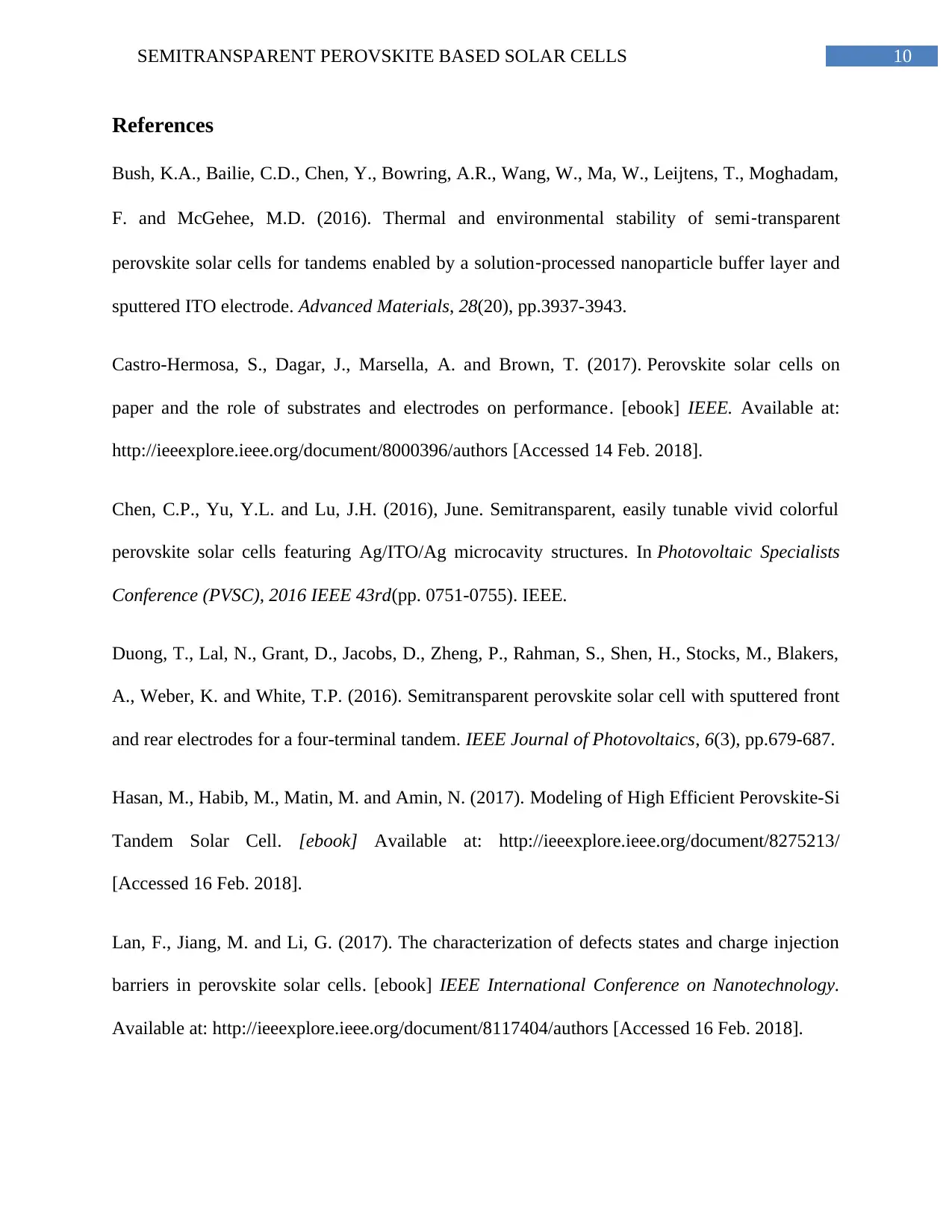
10SEMITRANSPARENT PEROVSKITE BASED SOLAR CELLS
References
Bush, K.A., Bailie, C.D., Chen, Y., Bowring, A.R., Wang, W., Ma, W., Leijtens, T., Moghadam,
F. and McGehee, M.D. (2016). Thermal and environmental stability of semi‐transparent
perovskite solar cells for tandems enabled by a solution‐processed nanoparticle buffer layer and
sputtered ITO electrode. Advanced Materials, 28(20), pp.3937-3943.
Castro-Hermosa, S., Dagar, J., Marsella, A. and Brown, T. (2017). Perovskite solar cells on
paper and the role of substrates and electrodes on performance. [ebook] IEEE. Available at:
http://ieeexplore.ieee.org/document/8000396/authors [Accessed 14 Feb. 2018].
Chen, C.P., Yu, Y.L. and Lu, J.H. (2016), June. Semitransparent, easily tunable vivid colorful
perovskite solar cells featuring Ag/ITO/Ag microcavity structures. In Photovoltaic Specialists
Conference (PVSC), 2016 IEEE 43rd(pp. 0751-0755). IEEE.
Duong, T., Lal, N., Grant, D., Jacobs, D., Zheng, P., Rahman, S., Shen, H., Stocks, M., Blakers,
A., Weber, K. and White, T.P. (2016). Semitransparent perovskite solar cell with sputtered front
and rear electrodes for a four-terminal tandem. IEEE Journal of Photovoltaics, 6(3), pp.679-687.
Hasan, M., Habib, M., Matin, M. and Amin, N. (2017). Modeling of High Efficient Perovskite-Si
Tandem Solar Cell. [ebook] Available at: http://ieeexplore.ieee.org/document/8275213/
[Accessed 16 Feb. 2018].
Lan, F., Jiang, M. and Li, G. (2017). The characterization of defects states and charge injection
barriers in perovskite solar cells. [ebook] IEEE International Conference on Nanotechnology.
Available at: http://ieeexplore.ieee.org/document/8117404/authors [Accessed 16 Feb. 2018].
References
Bush, K.A., Bailie, C.D., Chen, Y., Bowring, A.R., Wang, W., Ma, W., Leijtens, T., Moghadam,
F. and McGehee, M.D. (2016). Thermal and environmental stability of semi‐transparent
perovskite solar cells for tandems enabled by a solution‐processed nanoparticle buffer layer and
sputtered ITO electrode. Advanced Materials, 28(20), pp.3937-3943.
Castro-Hermosa, S., Dagar, J., Marsella, A. and Brown, T. (2017). Perovskite solar cells on
paper and the role of substrates and electrodes on performance. [ebook] IEEE. Available at:
http://ieeexplore.ieee.org/document/8000396/authors [Accessed 14 Feb. 2018].
Chen, C.P., Yu, Y.L. and Lu, J.H. (2016), June. Semitransparent, easily tunable vivid colorful
perovskite solar cells featuring Ag/ITO/Ag microcavity structures. In Photovoltaic Specialists
Conference (PVSC), 2016 IEEE 43rd(pp. 0751-0755). IEEE.
Duong, T., Lal, N., Grant, D., Jacobs, D., Zheng, P., Rahman, S., Shen, H., Stocks, M., Blakers,
A., Weber, K. and White, T.P. (2016). Semitransparent perovskite solar cell with sputtered front
and rear electrodes for a four-terminal tandem. IEEE Journal of Photovoltaics, 6(3), pp.679-687.
Hasan, M., Habib, M., Matin, M. and Amin, N. (2017). Modeling of High Efficient Perovskite-Si
Tandem Solar Cell. [ebook] Available at: http://ieeexplore.ieee.org/document/8275213/
[Accessed 16 Feb. 2018].
Lan, F., Jiang, M. and Li, G. (2017). The characterization of defects states and charge injection
barriers in perovskite solar cells. [ebook] IEEE International Conference on Nanotechnology.
Available at: http://ieeexplore.ieee.org/document/8117404/authors [Accessed 16 Feb. 2018].
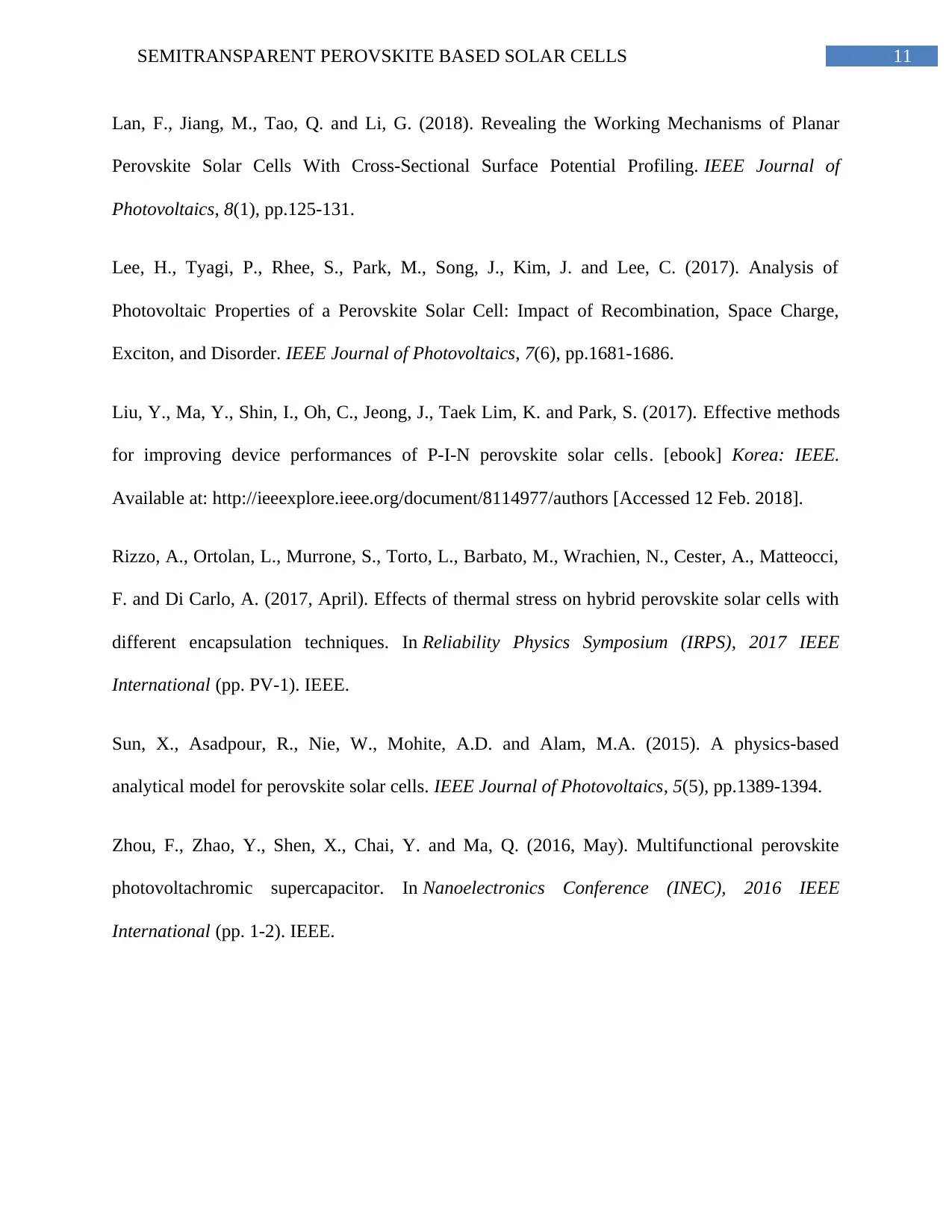
11SEMITRANSPARENT PEROVSKITE BASED SOLAR CELLS
Lan, F., Jiang, M., Tao, Q. and Li, G. (2018). Revealing the Working Mechanisms of Planar
Perovskite Solar Cells With Cross-Sectional Surface Potential Profiling. IEEE Journal of
Photovoltaics, 8(1), pp.125-131.
Lee, H., Tyagi, P., Rhee, S., Park, M., Song, J., Kim, J. and Lee, C. (2017). Analysis of
Photovoltaic Properties of a Perovskite Solar Cell: Impact of Recombination, Space Charge,
Exciton, and Disorder. IEEE Journal of Photovoltaics, 7(6), pp.1681-1686.
Liu, Y., Ma, Y., Shin, I., Oh, C., Jeong, J., Taek Lim, K. and Park, S. (2017). Effective methods
for improving device performances of P-I-N perovskite solar cells. [ebook] Korea: IEEE.
Available at: http://ieeexplore.ieee.org/document/8114977/authors [Accessed 12 Feb. 2018].
Rizzo, A., Ortolan, L., Murrone, S., Torto, L., Barbato, M., Wrachien, N., Cester, A., Matteocci,
F. and Di Carlo, A. (2017, April). Effects of thermal stress on hybrid perovskite solar cells with
different encapsulation techniques. In Reliability Physics Symposium (IRPS), 2017 IEEE
International (pp. PV-1). IEEE.
Sun, X., Asadpour, R., Nie, W., Mohite, A.D. and Alam, M.A. (2015). A physics-based
analytical model for perovskite solar cells. IEEE Journal of Photovoltaics, 5(5), pp.1389-1394.
Zhou, F., Zhao, Y., Shen, X., Chai, Y. and Ma, Q. (2016, May). Multifunctional perovskite
photovoltachromic supercapacitor. In Nanoelectronics Conference (INEC), 2016 IEEE
International (pp. 1-2). IEEE.
Lan, F., Jiang, M., Tao, Q. and Li, G. (2018). Revealing the Working Mechanisms of Planar
Perovskite Solar Cells With Cross-Sectional Surface Potential Profiling. IEEE Journal of
Photovoltaics, 8(1), pp.125-131.
Lee, H., Tyagi, P., Rhee, S., Park, M., Song, J., Kim, J. and Lee, C. (2017). Analysis of
Photovoltaic Properties of a Perovskite Solar Cell: Impact of Recombination, Space Charge,
Exciton, and Disorder. IEEE Journal of Photovoltaics, 7(6), pp.1681-1686.
Liu, Y., Ma, Y., Shin, I., Oh, C., Jeong, J., Taek Lim, K. and Park, S. (2017). Effective methods
for improving device performances of P-I-N perovskite solar cells. [ebook] Korea: IEEE.
Available at: http://ieeexplore.ieee.org/document/8114977/authors [Accessed 12 Feb. 2018].
Rizzo, A., Ortolan, L., Murrone, S., Torto, L., Barbato, M., Wrachien, N., Cester, A., Matteocci,
F. and Di Carlo, A. (2017, April). Effects of thermal stress on hybrid perovskite solar cells with
different encapsulation techniques. In Reliability Physics Symposium (IRPS), 2017 IEEE
International (pp. PV-1). IEEE.
Sun, X., Asadpour, R., Nie, W., Mohite, A.D. and Alam, M.A. (2015). A physics-based
analytical model for perovskite solar cells. IEEE Journal of Photovoltaics, 5(5), pp.1389-1394.
Zhou, F., Zhao, Y., Shen, X., Chai, Y. and Ma, Q. (2016, May). Multifunctional perovskite
photovoltachromic supercapacitor. In Nanoelectronics Conference (INEC), 2016 IEEE
International (pp. 1-2). IEEE.
1 out of 12
Your All-in-One AI-Powered Toolkit for Academic Success.
+13062052269
info@desklib.com
Available 24*7 on WhatsApp / Email
![[object Object]](/_next/static/media/star-bottom.7253800d.svg)
Unlock your academic potential
© 2024 | Zucol Services PVT LTD | All rights reserved.